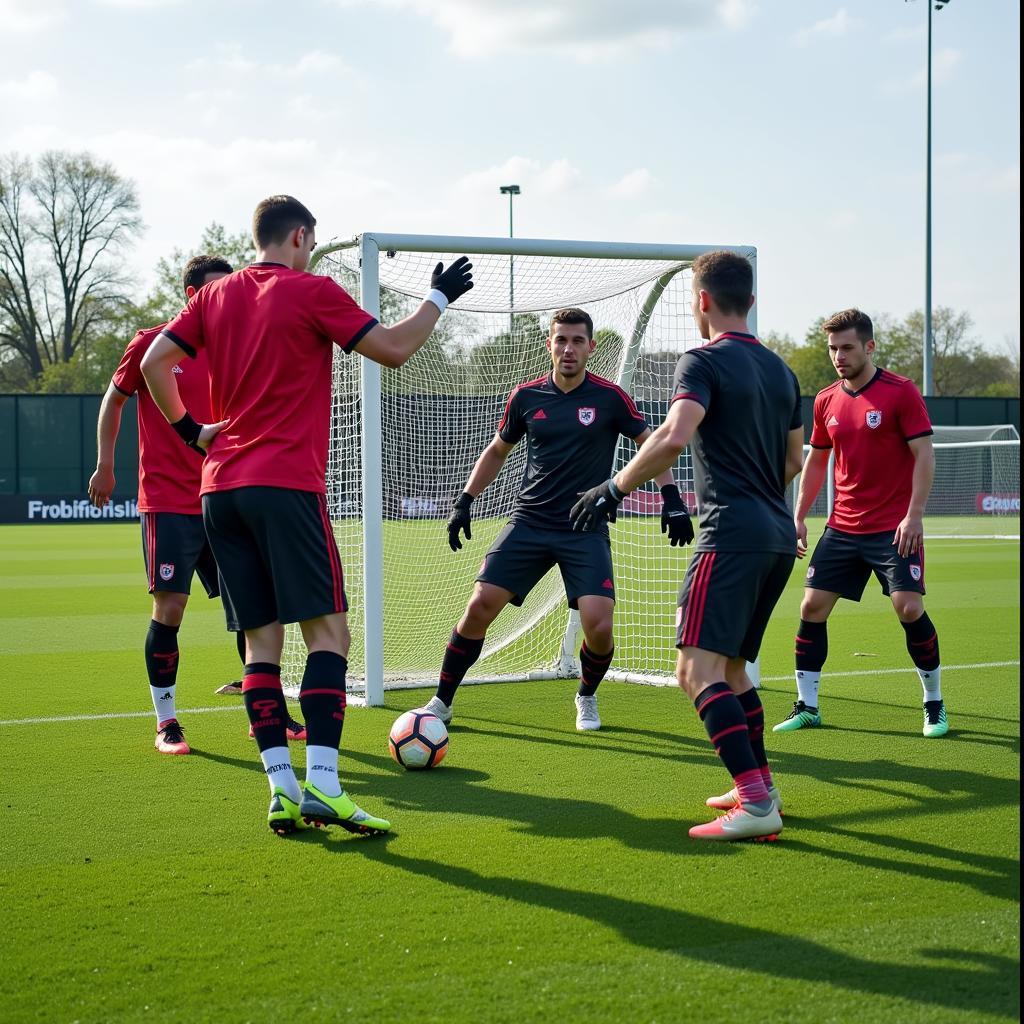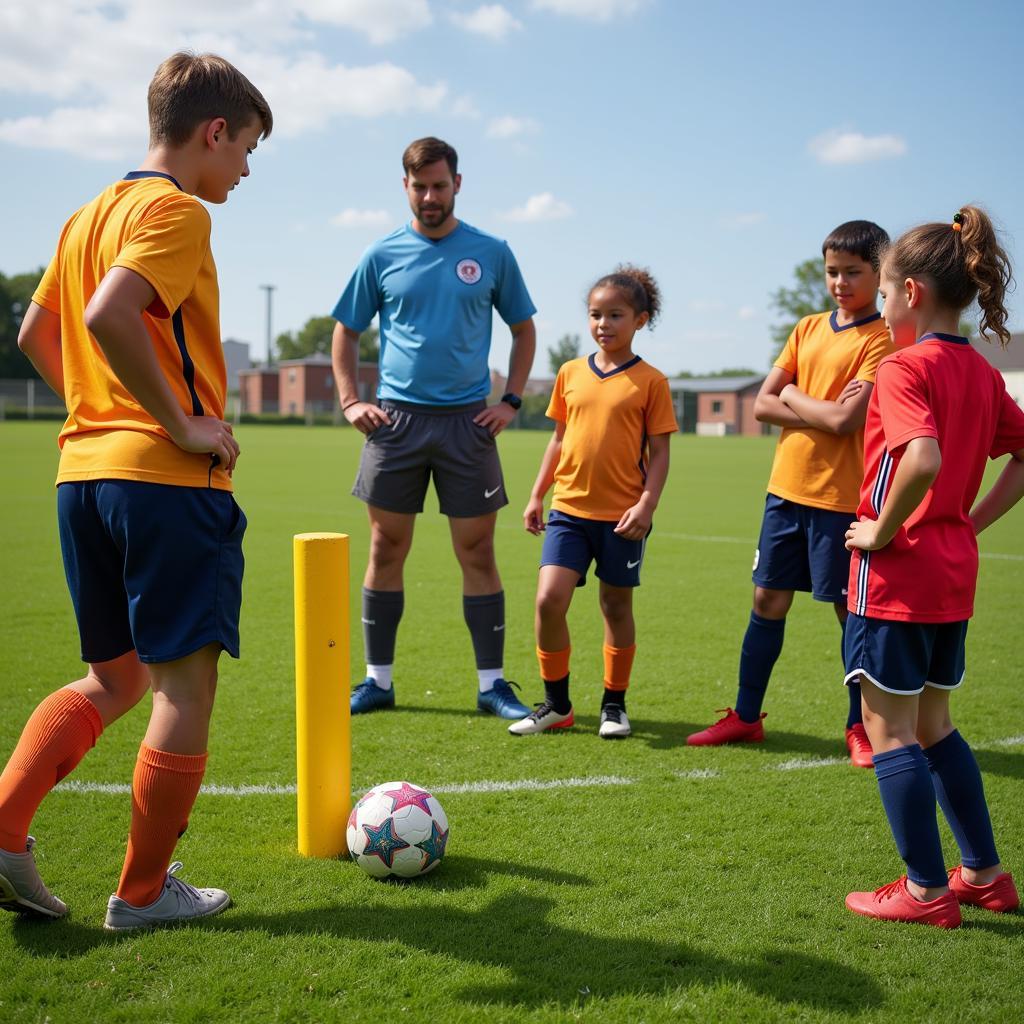Free Kick Dummies. Essential tools for any team serious about improving their set piece play. Whether you’re practicing curving free kicks around a wall or perfecting those powerful, driven shots, a free kick dummy provides a realistic target that simulates the presence of opposing players. But how do you choose the right dummy? And how can you maximize your training using this essential piece of equipment? This guide has everything you need to know.
Choosing the Perfect Free Kick Dummy: Factors to Consider
Finding the perfect free kick dummy can feel overwhelming with so many options available. Here are the key factors to consider:
- Height and Size: Dummies come in various heights to replicate different defensive scenarios. Consider the age and skill level of your players. Younger players might benefit from shorter dummies, while older, more experienced players might require taller dummies to simulate real-game situations.
- Material and Durability: Free kick dummies are typically made from PVC, inflatable materials, or a combination of both. PVC dummies are generally more durable and withstand powerful shots, making them suitable for older players. Inflatable dummies are lightweight and easier to move around, making them ideal for younger players and various drills.
- Stability: A stable dummy is crucial for effective training. Look for dummies with wide bases or weighting systems that prevent them from tipping over easily, even after repeated impacts.
- Portability: Consider how easy the dummy is to transport and store. Inflatable dummies are usually more portable than their PVC counterparts, but some PVC dummies come with convenient carrying bags.
- Price: Free kick dummies are available at various price points. Determine your budget and prioritize features that align with your team’s specific needs and training goals.
Maximizing Your Training with Free Kick Dummies: Tips and Drills
 Soccer players practicing free kicks with a dummy
Soccer players practicing free kicks with a dummy
Simply having a free kick dummy doesn’t automatically translate to improved free kicks. Here’s how to get the most out of your training:
Drills for Accuracy:
- Target Practice: Place the dummy in different positions around the penalty box, focusing on bending the ball around the dummy and into the goal. Start with closer distances and gradually increase the range as accuracy improves.
- Wall Drills: Use multiple dummies to create a simulated wall of defenders. Practice curving the ball over the wall and dipping it back down towards the goal.
Drills for Power:
- Direct Free Kick Challenge: Position the dummy directly in front of the goal and challenge players to strike the ball with power and accuracy. Focus on technique and follow-through to maximize shot power.
- Long-Range Bombardment: Place the dummy further away from the goal and have players practice long-range free kicks. This drill helps develop leg strength and the ability to generate power from distance.
Advanced Drills:
- Combination Plays: Use the dummy to simulate a defender rushing out to block a free kick. Players can practice passing the ball around the dummy to a teammate in a better shooting position.
- Game-Situational Drills: Recreate realistic game scenarios using the dummy, such as a free kick near the corner flag or a free kick just outside the penalty box. This helps players develop decision-making skills and practice different free kick strategies.
Beyond the Basics: Additional Considerations for Free Kick Mastery
- Technique is Key: While the dummy provides a target, emphasize proper free kick technique, including foot placement, body positioning, and follow-through.
- Visualize Success: Encourage players to visualize the trajectory of the ball and the desired outcome before each kick. This mental rehearsal can enhance focus and improve execution.
- Progressive Overload: Gradually increase the difficulty of drills by adding defenders, changing distances, or introducing time constraints.
- Record and Analyze: Film training sessions and review the footage with players, identifying areas for improvement and celebrating successes.
“A free kick dummy is more than just a stationary opponent,” says Coach Emily Carter, former professional soccer player and renowned youth coach. “It’s a valuable tool for developing technique, strategy, and the mental fortitude required to excel in pressure situations.”
 Young soccer players learning free kick techniques with a dummy
Young soccer players learning free kick techniques with a dummy
Free Kick Dummy FAQs
Q: How many free kick dummies do I need for effective training?
A: One or two dummies are sufficient for most individual and small group drills. For larger teams and more complex drills, having three or four dummies provides greater versatility.
Q: Can free kick dummies be used for other sports?
A: Absolutely! While primarily designed for soccer, free kick dummies can be adapted for use in other sports like rugby, Gaelic football, and American football, simulating defensive players or obstacles.
Q: How do I clean and maintain my free kick dummy?
A: Most free kick dummies can be easily cleaned with a damp cloth and mild detergent. Regularly inspect the dummy for any signs of damage and address them promptly to ensure longevity.
Unlock Your Free Kick Potential
Investing in a high-quality free kick dummy is investing in your team’s success. By incorporating dummy drills into your training regimen and focusing on proper technique, you’ll be well on your way to transforming free kicks from potential threats into scoring opportunities. Remember, practice makes perfect!
Need help choosing the right free kick dummy or want more training tips? Contact us at Phone Number: 0972669017, Email: [email protected], or visit us at 142 Tran Nhan Tong, Yen Thanh, Uong Bi, Quang Ninh, Vietnam. Our 24/7 customer support team is here to help you take your free kick game to the next level!